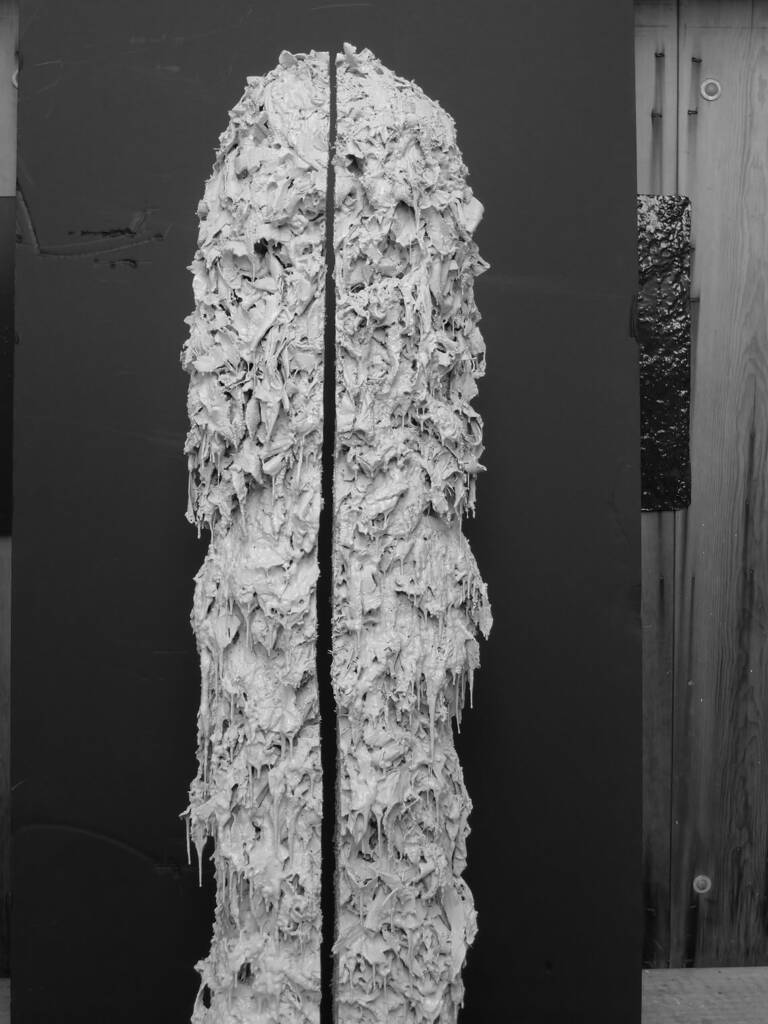Helmut Lang stepped away from fashion in 2005. What followed was not a withdrawal, but a reorientation: a shift in mediums rather than vision. The audacity of this move has only deepened his mystique, securing his place as a cultural icon whose influence is impossible to imitate or ignore. Two decades on, and Lang’s journey into the realm of contemporary art has quietly affirmed the integrity of this decision. Through a sculpture-based practice, he continues to pursue the enquiries that shaped his fashion oeuvre: explorations of materiality and form, the tension between opposing forces, and the boundaries and permanence of the self.
Lang’s most recent exhibition, What remains behind, was on view earlier this year at the Schindler House, a storied building that is part of the MAK Center for Art and Architecture in Los Angeles. This new series of sculptures, composed of industrial materials and salvaged objects—discarded foam, fragile tissue, blocks of wax—embodies a convergence of material and memory. Resistant to fixed interpretation, the works are shaped by what Lang describes as “imprints of inescapables”: history, time, and experience. In conversation, Lang is thoughtful but not performative. With hube, he discusses the autonomy of artwork, the imprint of heritage, and the urgency of creating “uncalculated, fearless” work in a time of widespread uncertainty.
hube: In the world of art and creativity, what captivates you more—questions or answers?
Helmut Lang: It is always questions and answers, like twin peaks.
h: You have a unique relationship with space and architecture. Do you consider how your works will resonate with their surroundings?
HL: The object and its integrity are the most important. Context and placement can be vital if you have to respond to a certain environment or if the space around the object becomes part of it. On the other hand, I am also willing to let a space violate the sculptures and avoid the trap of beautifying the object. I want to think that a sculpture will eventually be placed in different contexts and will respond for better or worse each time. Also, one cannot always choose where it will end up, and I don’t want to be consumed by that fact. There is something interesting about not always being in control beyond the creation of the object.
h: Art is intricately connected to time. How do the past and future influence you? What role does heritage play in your creative practice, and how do you engage with it?
HL: Art should be timeless. It also reads and communicates differently in relation to other times and environments.
All times‚ lived or to be lived, matter when my work is in progress. Essentially, one works with implied premonitions or what they have unconsciously or consciously experienced so far.
Heritage has imprints of inescapables [sic] that were implemented without asking. It is a good base to dismiss, enhance, radicalise and move forward from, towards the unknown. It is as inescapable as past time.
h: For you and your audience, what is more important: understanding art or feeling it?
HL: At best, art always raises more questions than answers.
I don’t think art is responsible for being understood. It is the emotional part that is the interesting part.

UNTITLED (detail), 2012–13
Courtesy of HELMUT LANG, copyright of HL-ART

Photography by DANIEL TRESE

